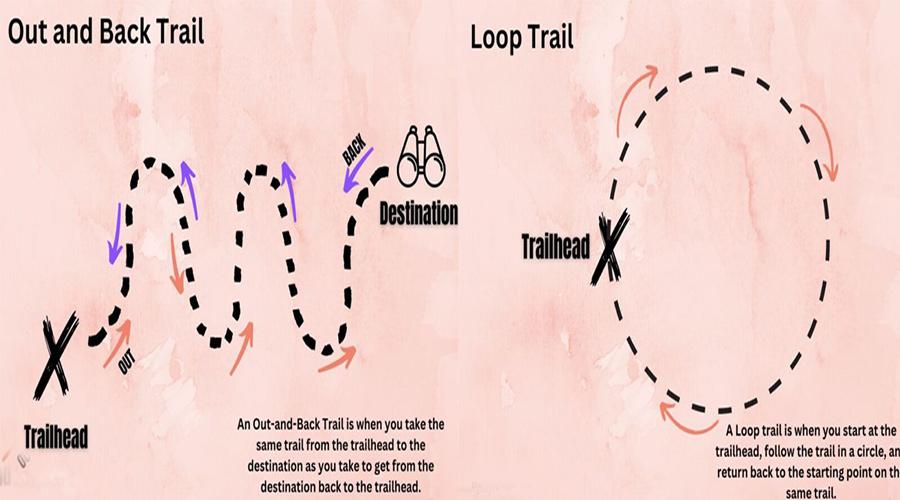Exploring Trails: What Does Out and Back Trail Mean?
Have you ever heard the phrase out-and-back trails when people are talking about hiking trails, but didn’t know what it meant?
Perhaps you’ve seen signs for out-and-back trails at your local park but never found out what that meant. but never found out what that signified.
Don’t worry, you’re not alone. We’ll explain what an out-and-back trail is and help you decide if it’s the right choice for your next adventure.
Hiking is a fun activity, no matter your level of experience. If you are new to hiking, there are different types of trails that will fit your experience. I would recommend taking an out-and-back trail, which is one of the easiest routes you can do as a beginner.
In this article, I’ll take a deep dive into what exactly what does out-and-back trails mean, and show you why this type of route might be the perfect choice for your next hike.
- What defines an out-and-back trail?
- What does “out-and-back” mean in terms of the length of a trail?
- What are the benefits of out-and-back trails?
- Potential drawbacks of an out-and-back trail
- Tips for navigating an out-and-back trail
- Know your limits
- Get an early start
- Stay focused
- Different types of out-and-back trails
- Loop trails
- Point-to-point trails
- Inverse out and back trails
- What’s the difference between an out-and-back trail and a loop trail?
- How to plan an effective out-and-back trail hike
- Map out your route
- Bring plenty of water
- Bring the necessary gear
- Common safety precautions for out and back trails
- Packing appropriate supplies
- Checking weather conditions
- Being realistic in choosing trail condition
- Knowing your way back
- Conclusion
- FAQ
- What is a round-trip hike?
- Is Out and Back the Same as Round Trip?
- What Does 5 Miles Out and Back Mean?
What defines an out-and-back trail?
- An out-and-back trail starts and ends at the same place.
- It follows a single path from the starting point to a designated endpoint or turnaround point, and then returns along the same path to the starting point. Usually, the turnaround point is a viewpoint or attraction such as a waterfall, lake, mountain view, etc.
- Hikers travel out to the endpoint and back to the starting point on the same trail, completing a roundtrip journey.
- Out-and-back trails are easy to navigate, as the path is the same in both directions.
- This trail layout offers a clear and predictable path, suitable for various skills and preferences.
Here’s an example of an out-and-back trail on AllTrails:
Trail Name: Mount Tallac Trail
Location: Lake Tahoe, California
Trail Length: Approximately 10 miles roundtrip
The Mount Tallac Trail is a popular out-and-back hike in the Lake Tahoe area. The trail starts at the Mount Tallac Trailhead and follows a well-marked path through dense forests and rocky terrain.
As you hike, you’ll pass through meadows dotted with wildflowers and eventually reach the summit of Mount Tallac. From there, you’ll be rewarded with stunning panoramic views of Lake Tahoe and the surrounding Sierra Nevada mountains.
After taking in the scenery, you’ll retrace your steps back to the trailhead to complete the hike.

What does “out-and-back” mean in terms of the length of a trail?
The length of an out-and-back trail is typically measured as the total distance traveled from the starting point to the turnaround point and back again. For example, if you hike 3 miles from the trailhead to the endpoint and then return the same way, the total length of the out-and-back trail would be 6 miles.
It refers to a specific type of trail where you follow a single path from a starting point to a designated endpoint or turnaround point and then return along the same path to the starting point.
It’s often used for shorter hikes, with the trail distance from the beginning to an endpoint being no more than 10 miles.
When considering the total distance of your chosen out-and-back trail, it is important to understand how they might be conveyed in hiking apps or on hiking websites. Apps and websites will most likely show the entire roundtrip mileage.
Hiking apps like AllTrails include the roundtrip mileage of out and back trails (also sometimes referred to as a point-to-point trail). This means that their out and back trails are described in the total miles that will be hiked roundtrip. Many hiking apps, such as AllTrails, provide the total mileage for out and back trails, which are also known as point-to-point trails. This means that the total distance to be hiked roundtrip is described in the app.
For example, if AllTrails indicates a hike is 10 miles out and back, it means that the trail is 5 miles in each direction. This creates a roundtrip distance of 10 miles. Therefore a 10-mile roundtrip hike will be 5 miles up and 5 miles down.

What are the benefits of out-and-back trails?
Easy to enjoy your experience: The beauty of an out-and-back type of trail is that you don’t need to worry about getting lost because they always go on the same trail on their way there and on their way back to the trailhead.
Builds Confidence and Comfort: Having to use the route twice will build confidence due to familiarity with the path, especially in going back to the starting point.
Ease of Navigation: Out-and-back trails are great for hikers who don’t want to worry about navigating a complex network of trails with multiple intersections and forks, as well as for families who want to turn back if their hike takes too long.
Enhanced Experience: These trails often feature extra amenities like benches, viewpoints, bridges, and more that help to enhance your experience.
Ideal for beginners: They’re usually shorter than loops and don’t require any additional supplies or skills to complete—all you need is good footwear, a map, some water, and a sense of adventure!
Group-Friendly: Out-and-back trails are also great for groups since it’s easy to keep track of each other and enjoy the journey together.

Potential drawbacks of an out-and-back trail
While out-and-back trails offer simplicity and a clear route, it’s essential to consider these potential drawbacks and weigh them against your preferences and hiking objectives.
Repetitive Scenery: Since you’re retracing your steps on the return journey, you may find the scenery and terrain repetitive, which can make the experience less engaging, potentially causing you to miss out on experiencing diverse landscapes.
Diminished Adventure: Knowing you’ll be traveling back along the same path can diminish the sense of adventure and spontaneity that comes with exploring new trails.
Congestion Concerns: Popular out-and-back trails may experience congestion, especially near the trailhead or at notable landmarks, detracting from the tranquility of the hike.
Tips for navigating an out-and-back trail
The out-and-back trail is a fairly straightforward hiking trail—you start at one point and go until you reach the end, then turn around and head back to where you started.
It is easy to navigate and sounds simple, but there are a few important tips to bear in mind when navigating one.
Here are some tips to help you make the most of out-and-back hikes.
Know your limits
The out-and-back trail takes twice as long to complete as a loop trail since you’re covering the same path twice.
It’s important to know your fitness level so that you don’t push yourself too hard. Nobody wants an exhausted hiker on the hiking trail!
You will want to make sure that you note what your total mileage will be when considering trail markers on the actual trail.
Always keep in mind when you are hiking on a trail, it is important to keep track of your total mileage, especially when using trail markers.
Always remember that you will have to make the return trip, so consider factors such as elevation gain. For instance, if you hike 3 miles downhill on the way in, it will be much harder to hike the same 3 miles uphill on the way back.

Get an early start
Start your hike early in the day so that you have plenty of time to reach your destination without having to rush.
That way, if you encounter any unexpected obstacles on the way, such as loose gravel or heavy rain, you have plenty of time to navigate back to the trailhead safely.
Stay focused
It can be easy to get distracted from time to time when taking an out-and-back trail — you cover the same stretch of land twice so it can become slightly repetitive.
To stay motivated, set realistic goals for yourself along the way.
For example, you might aim to reach a certain landmark before turning around or even just tick off hiking trail markers for each kilometer as they go by!

Different types of out-and-back trails
Out-and-back trails are a great way to enjoy nature, as well as test new gear, but there are different types of out-and-back trails you should know about.
Let’s take a look at some of the different trail route types.
Loop trails
A loop trail is simply when the route starts at the same place and ends at the same point, with a loop in the middle — basically, an out-and-back trail with a detour.
These trails can be anything from short circuits to more complex loops with multiple trails that extend for several miles.
Point-to-point trails
Point-to-point trail is usually longer, as it’ll typically have you cover more than one location during your journey.
As the name implies, these types of trails go from point A to point B, versus out-and-back hikes, along the trail distance on one route. Such trails are also good for testing new gear.
These routes are often part of a multi-day hiking or backpacking trip or segments of a long-distance trail such as the Appalachian Trail or Pacific Crest Trail.
Inverse out and back trails
Inverse out and back trails type of trail may seem confusing at first, but they’re quite simple —you go out one way, then come back another way.
This type of trail is great when you want to end up somewhere different from where you start, as these trails often mix up various routes for an interesting journey!

What’s the difference between an out-and-back trail and a loop trail?
Another popular type of trail that can be found on hiking websites is the loop type of trail.
How does it compare to a trail that goes up and down? As you can see, a trail from A to B is a path that runs from point B to point B and then returns to point B to point C in the same path.
Both trails are paved from the start to the end. In addition, the round trip also features the same beginning and end points (sometimes called Trailhead), but the back point trail no longer repeats any part of the trail.
The trail goes straight back instead. During the round trip, we are hiking a loop.

How to plan an effective out-and-back trail hike
The out-and-back trail hike is a great way to get some mileage in, explore nature, and stay safe.
It’s important to be sure you plan your hike effectively so you can enjoy the journey.
Here are a few tips on making the most of your out-and-back trail hike:
Map out your route
Map out the route you will take ahead of time, including where you will turn around and any potential hazards along the way.
This is especially important if you are unfamiliar with the area or if it’s your first time hiking trail.
Take a look at a topographic map to get an understanding of what terrain or elevation changes you might encounter on a day hike so that you can plan for them accordingly.
Bring plenty of water
Hydration is key when hiking on an out and back trail, as it can be easy to underestimate how much water you’ll need while hiking in hot weather or over longer distances.
Consider bringing an extra liter of water just in case, and drink often to avoid dehydration.
Bring the necessary gear
Bring all the necessary gear for your hike, including a first aid kit, headlamp, map and compass, snacks/food, extra clothing layers, and rain gear (just in case!). Don’t forget to bring some cool hiking gadgets that can make your trip better.
Also, be sure to wear proper hiking boots and clothing for a day hike, so that you’re prepared for whatever Mother Nature throws at you!

Common safety precautions for out and back trails
An out-and-back trail is a type of hike that requires careful planning and execution.
Before starting, it’s important to take certain precautions to ensure your safety.
Here are some of the most common safety measures for this type of hike:
Packing appropriate supplies
Always remember to pack enough food and water, a first aid kit, an emergency blanket, and additional layers of clothing in case the weather changes.
Additionally, it’s important to bring a phone charger as well as a GPS or compass if you plan on going off-trail at any point.
Checking weather conditions
It’s vital to check the weather conditions before leaving, so bring appropriate clothing and sunscreen if necessary.
Pay attention to the terrain you will be walking on, so you can dress appropriately with heavy-duty shoes or waterproof hiking boots.

Being realistic in choosing trail condition
For beginner hikers, out and back trails can offer a comfortable and manageable experience.
These trails are typically shorter in length and easier in terms of terrain, with gentle slopes and well-maintained paths.
Beginner hikers can enjoy the scenery and the fresh air without feeling overwhelmed or intimidated by a more challenging round trip.
For intermediate hikers, out and back trails can provide a bit more of a challenge.
These trails may be longer and feature steeper inclines, steep climbs, uneven terrain, and more rugged paths.
Intermediate hikers can enjoy the physical challenge of the round trip while still being able to retrace their steps back to the trail marker or starting point if they need to.
For experienced hikers, out and back trails can still offer a challenging experience.
These trails may be longer, steeper, and more difficult in terms of terrain.
Experienced hikers can push themselves to their limits while still being able to return to the starting point safely.
These trails may also offer more remote and rugged environments, providing experienced and novice hikers with a sense of adventure and exploration.
Overall, out and back trails are a great option for hikers of all skill levels. With different difficulty levels available, hikers can choose a trail distance and elevation gain that suits their needs and abilities, while still enjoying the beauty of nature and the physical challenge of the round trip.

Knowing your way back
Mark your path using trail markers or GPS coordinates when possible so that it’s easier for you to know the right direction and where to go should you get lost.
Additionally, make sure someone knows where you’re going in case of an emergency.
You will want to make sure that you note what your total mileage will be when considering trail markers on the actual trail. Always keep in mind that you have to make the return trip.
Finally, it never hurts to print out a map of the area in case your phone dies, or your GPS fails while hiking.
By taking certain precautions before embarking on an out-and-back trail, you can ensure you stay safe while exploring nature.

Conclusion
In short, the out-and-back trail is a hiking route that leads you to your starting point after a set distance.
This makes it a popular choice for hikers looking for an easy, comfortable, and safe trek.
These trails can be found in scenic settings and often offer great views of the surrounding landscape.
Whether you are a beginner hiker, a seasoned trailblazer, or simply looking for a unique way to explore the great outdoors, an out-and-back trail can be the perfect way to do it.
The only thing you need to do is lace up your boots, follow the trail, and enjoy the journey.
FAQ
What is a round-trip hike?
A round-trip hike is one where you start and finish at the same point, covering a loop or out-and-back trail. This type of hike is convenient as you don’t need to arrange transportation at the end of your route, and you get to experience different scenery along the way. Popular round trip hikes include scenic loops and out-and-back trails that showcase stunning natural landscapes.
Is Out and Back the Same as Round Trip?
“Out and back” and “round trip” are used interchangeably. Both refer to a journey where hikers go from a starting point to a destination and return to the starting point along the same path. “Out and back” emphasizes the direction, when hikers go out to a certain point and then return back along the same route, while “round trip” highlights the completion of the journey, indicating that hikers return to the starting point after reaching the destination.
What Does 5 Miles Out and Back Mean?
When we say ‘out and back’ for a 5-mile hike, it means that you will walk 2.5 miles from the starting point to a turnaround point and then return to the starting point along the same path, covering another 2.5 miles. So, the total distance you will walk will be 5 miles, which is the roundtrip distance.
Also Read About The 3 Most Popular Styles of Hiking Deconstructed
Want to learn more about hiking for beginners on a budget, hiking tips, and hiking destinations?



![What is considered a long hike? [8 factors to consider] What Is Considered A Long Hike: Top 3 Tips & Best Guide](https://griffithparkhiker.com/wp-content/uploads/2024/01/griffithparkhiker-2-335x220.jpg)





